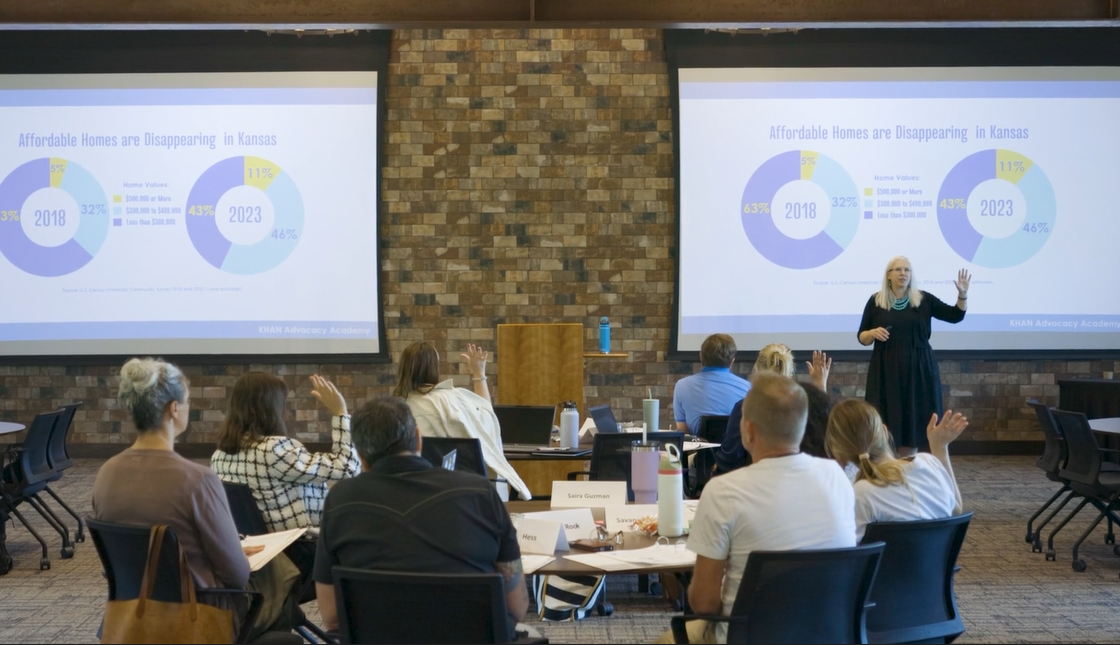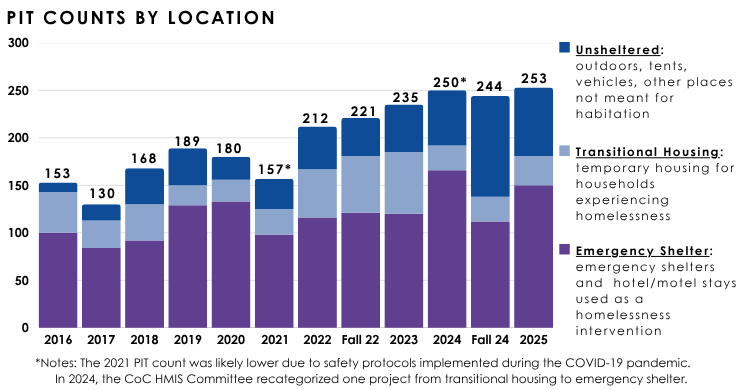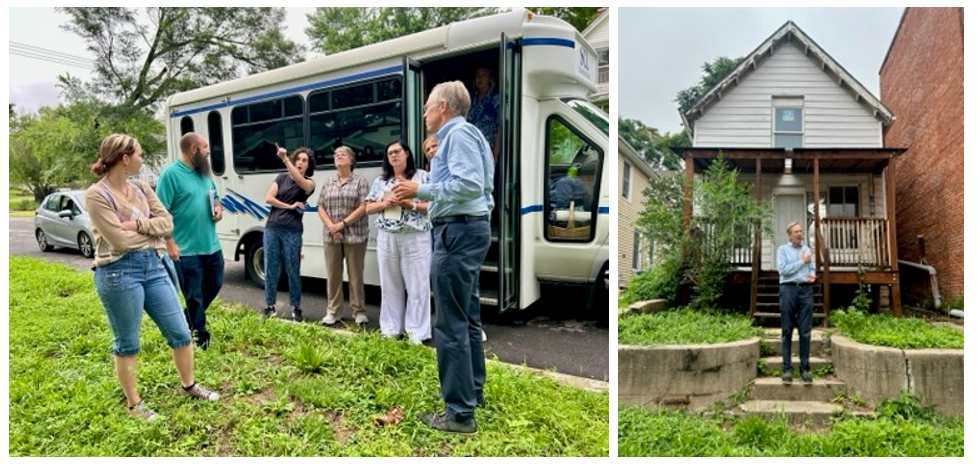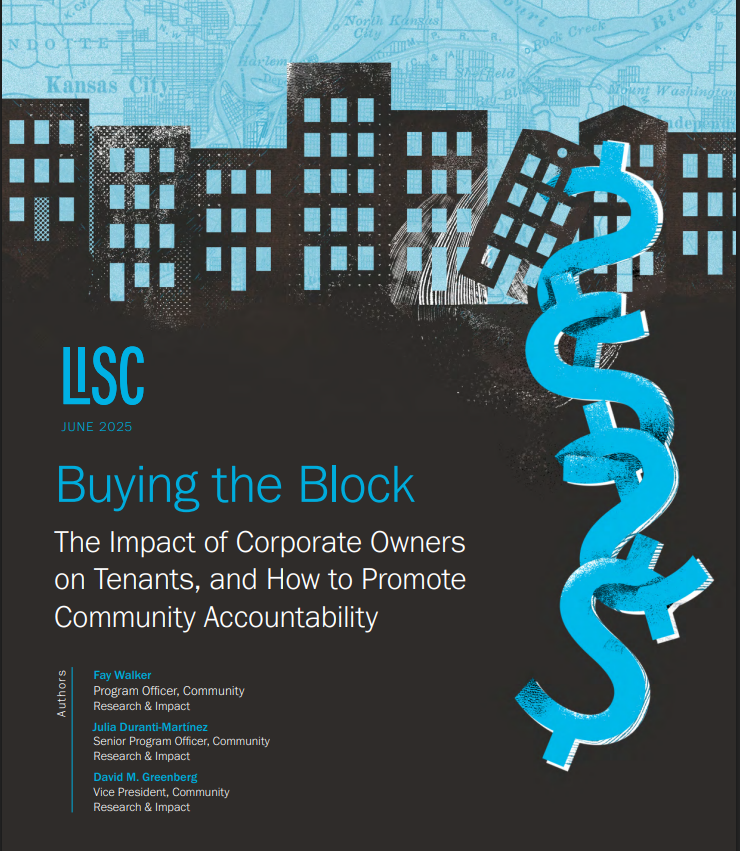
UCS and the Kansas Housing Advocacy Network (KHAN) launched their first statewide Advocacy Academy in Topeka this month, bringing together nonprofit leaders and community advocates from 14 different counties. Participants represent a wide range of communities—rural, suburban, and urban—underscoring the shared commitment to addressing housing challenges in every region of Kansas. By connecting advocates from across the state, the KHAN Advocacy Academy is creating a space for shared learning, peer support, and coordinated efforts to improve housing outcomes statewide.
Kristy Baughman, UCS Executive Director, Rachel Russel, UCS Director of Equity and Community Engagement, and Christina Ashie Guidry, UCS Director of Policy and Planning facilitated the four- hour session, beginning with a deep dive into advocacy fundamentals, exploring what it means to be an advocate and how to begin building influence from the ground up. Participants learned the distinctions between advocacy and lobbying, gained insight into different types of advocacy, and reflected on the housing issues that matter most in their communities. The session emphasized that effective, impactful advocacy can start with just one person. Additionally, by tapping into personal networks and shared values, participants can begin laying the groundwork for meaningful change.
“It’s such an amazing experience to work with people from so many parts of our state. Housing challenges exist across Kansas, but challenges in Wichita look different from challenges in Leavenworth. Our Advocacy Academy is providing tools and insight to help each community address their own specific challenges,” Kristy Baughman said.
The group also began mapping their own advocacy strategies, identifying connectors in their communities, and outlining future opportunities to share their messages. The interactive session laid the foundation for the remaining three sessions as participants prepare to develop persuasive messaging, engage decisionmakers, and champion housing solutions across Kansas. “This is an outstanding group of participants, and I can’t wait to see the ways they are going to impact their communities,” said Rachel Russell.
Annual Point-In-Time Count Data Reveals Trends in Homelessness

Johnson County’s Continuum of Care on Homelessness is a collaboration of public and private service providers committed to quickly and effectively responding to housing crises to either prevent or end homelessness among Johnson County residents. The U.S. Department of Housing and Urban Development (HUD) requires that Continuums of Care conduct an annual Point in Time (PIT) count of households within their geographic region experiencing homelessness on one night in the last ten days of January. The count is a snapshot on a single night that is used to monitor trends year to year and identify unmet needs among residents experiencing homelessness.
The PIT count includes people staying in shelters, transitional housing programs, or in unsheltered locations such as tents, vehicles, or other places not meant for habitation. HUD does not count households who are temporarily doubled up with friends or family.

The number of people counted during the 2025 PIT count was 253, a 65% increase from January 2016. Other notable trends over the last 10 years include:
The number of households with children has remained relatively flat in the county and the number of adults-only households has increased significantly. From 2016 to 2025, the number of adults-only households rose from 27 to 156, a 478% increase.
The number of people who were unsheltered on the night of the count rose significantly over time, from 10 people in the 2016 count to 72 people in the 2025 count, a 620% increase.
See the full fact sheet here.
Leavenworth Pilot to Tackle Abandoned Housing and Expand Housing Access

During the Kansas Housing Advocacy Network’s (KHAN) education and policy efforts across Kansas—from Garden City to Pittsburg—local leaders have consistently raised a pressing question: What can we do about abandoned housing?
UCS and KHAN are excited to highlight an innovative response taking shape in Leavenworth. A new pilot project will use the Kansas Abandoned Housing Act to support nonprofits in rehabilitating abandoned homes—helping address the state’s housing shortage, increase housing stability, and reduce homelessness.
“The Act is clear,” says Christina Ashie Guidry, UCS Director of Policy & Planning. “It allows nonprofits focused on housing to acquire title to homes that are at least two years tax delinquent, vacant for six months, and have serious code violations—once they pay the back taxes and complete full rehabilitation. It’s a powerful tool, and we’re working to finally put it into practice.”
To explore what’s possible, Christina connected with Katie Killen of Habitat for Humanity of Kansas City. Killen helped bring in Neighborhood Legal Support (NLS)—an organization with deep experience in successfully using Missouri’s version of the law to transform neighborhoods like Lykins in Kansas City. As Gregg Lombardi, Executive Director of NLS, shared: “We’ve turned over more than 120 abandoned properties in Missouri. Now, we’re ready to do the same in Kansas.”
Leavenworth emerged as a prime candidate. With a 98% occupancy rate and visible abandoned properties in its downtown core, city leaders—including Mayor Holly Pittman and City Manager Scott Petersen—were already seeking solutions. Local nonprofit DePaul Leavenworth Attainable Housing (DLAH), led by Sister Amy Willcott and Chris Leach, was eager to expand their work providing housing and support to households experiencing homelessness. Together with Myranda Agnew of the Kansas Statewide Homeless Coalition, they identified properties that meet the legal criteria and helped bring partners together.
On July 17, city officials, local leaders, and advocates gathered for a planning session and bus tour to evaluate potential properties. Participants included representatives from the City of Leavenworth, DLAH, NLS, Habitat for Humanity of Kansas City, KSHC, and UCS.
“Rehabilitating these homes improves not just housing access but also neighborhood pride,” said Katie Killen.
“Keeping these homes in the hands of a nonprofit like DLAH protects long-term affordability,” added Gregg Lombardi.
The result: DLAH and NLS will move forward with a pilot to rehabilitate two abandoned homes in downtown Leavenworth using the Kansas Abandoned Housing Act.
This pilot has the potential to serve as a statewide model for transforming abandoned housing into stable, affordable homes—especially in communities with strong nonprofit partners. KHAN will continue to track and share progress from the pilot.
For more information or to explore how this model could work in your community, contact:
Christina Ashie Guidry (christinag@ucsjoco.org)
Katie Killen (kkillen@habitatkc.org)
Gregg Lombardi (gregg@nls4kc.org)
Special thanks to the City of Leavenworth, DLAH, KSHC, Habitat for Humanity of Kansas City, and NLS for their innovation and leadership in addressing Kansas’ housing challenges.
New Report Highlights the Local Impact of Corporate Landlords
 In June, the Local Initiatives Support Corporation (LISC) released its Buying the Block report, offering valuable insights into the shift of the Kansas rental market from a “mom and pop” to a corporate enterprise. LISC’s report helps inform UCS’ ongoing work to ensure equal access to affordable, quality housing. LISC found that corporate landlords—those with 100 units or more—now own about 80% of multi-family housing units in the region. More than half of these landlords are based outside the region.
In June, the Local Initiatives Support Corporation (LISC) released its Buying the Block report, offering valuable insights into the shift of the Kansas rental market from a “mom and pop” to a corporate enterprise. LISC’s report helps inform UCS’ ongoing work to ensure equal access to affordable, quality housing. LISC found that corporate landlords—those with 100 units or more—now own about 80% of multi-family housing units in the region. More than half of these landlords are based outside the region.
Why does it matter where owners are located or how many properties they own? The LISC study confirms findings of other studies nationwide: corporate owners, particularly those located out-of-region operate differently than smaller or “mom and pop” owners. While “mom and pop” owners often reinvest in their properties and seek to reduce tenant turnover, out-of-region owners file for eviction at nearly three timesthe rate of local landlords and have incurred more than twice as many maintenance violations. Rather than reinvesting in existing properties, corporate owners often leverage the increasing property values of their units to purchase additional properties. The owners focus on purchasing undervalued assets, or units that are likely to have underlying safety risks or deferred maintenance. LISC notes that understanding the full scope of corporate landlord impact is very challenging because of lack of transparency in property ownership.
As a result, in the current rental market, Kansans are less likely to get what they’re paying for: Kansas law guarantees safe, habitable homes in exchange for rent, but there is no real enforcement mechanism.
How can we address this challenge and make sure Kansans get the safe, habitable housing they’re guaranteed under the law and are paying for? One crucial step is to have a statewide public database of rental properties that provides information about property ownership and housing conditions. Kansas landlords know who their tenants are: tenants compete for housing and pay application fees for landlords to run tenant screening reports on them. Kansas tenants should also know who they’re getting into business with, too, and whether the landlord or property management company is responsive to tenants and what condition its housing units are in. The state already maintains public databases for childcare childcare centers and pet shelters that provide information about ownership, complaints and condition of the centers. Our homes are where we sleep, live, and raise our children. Kansas renters should have at least the same level of insight into prospective homes as they do childcare or pet shelters.
